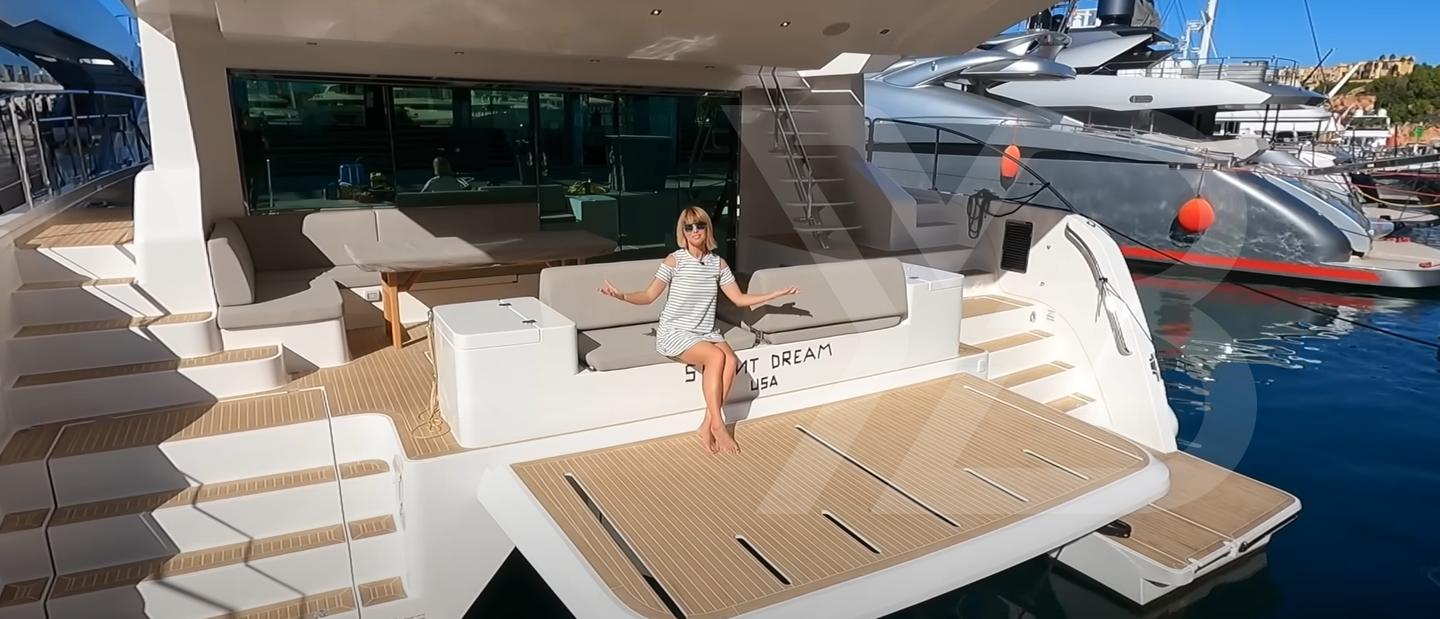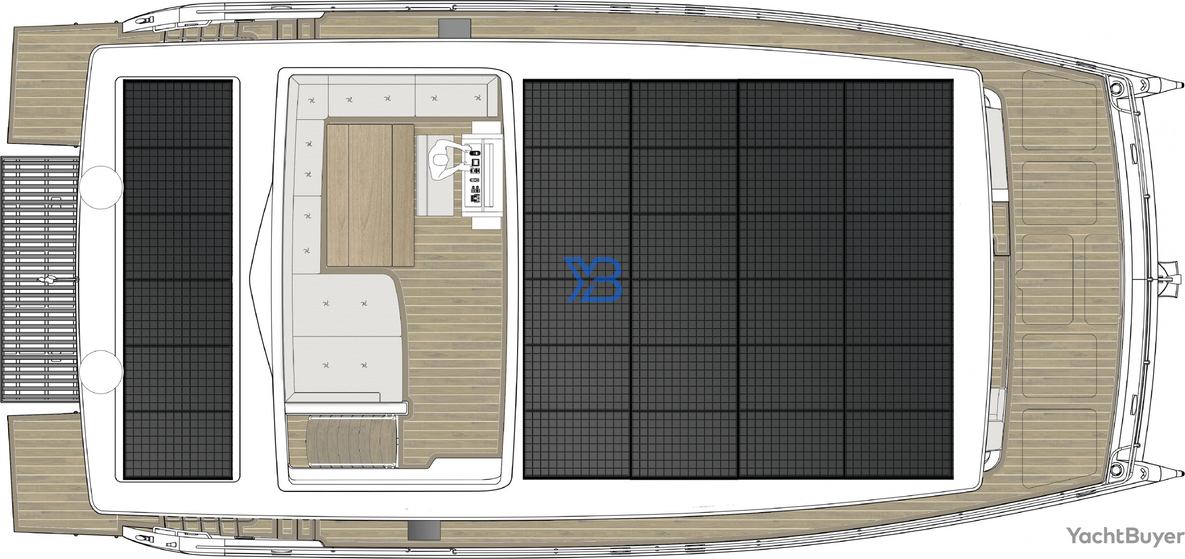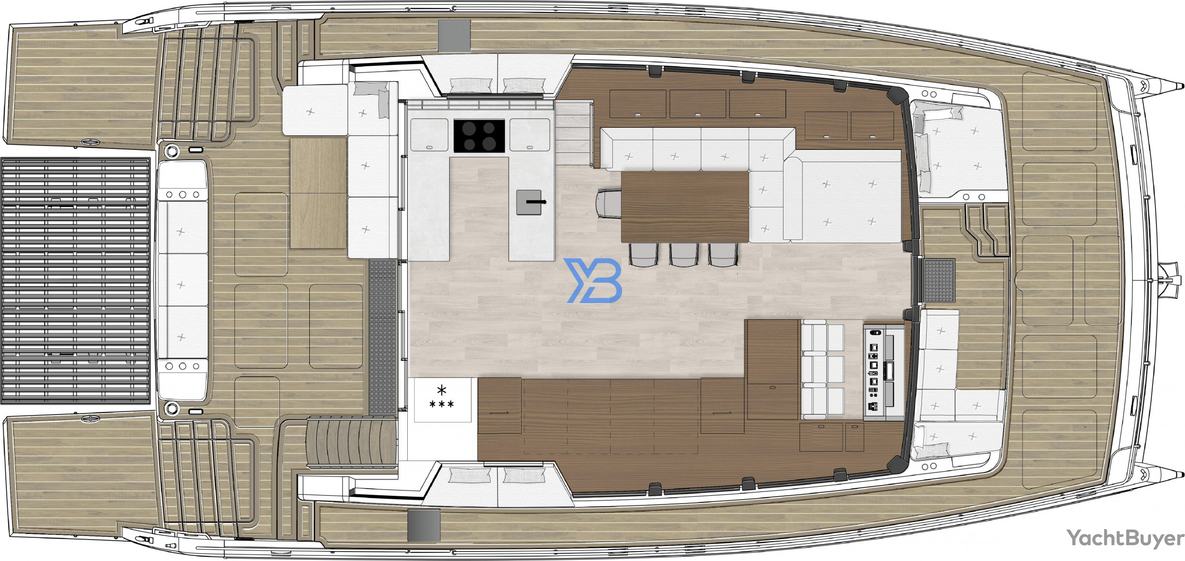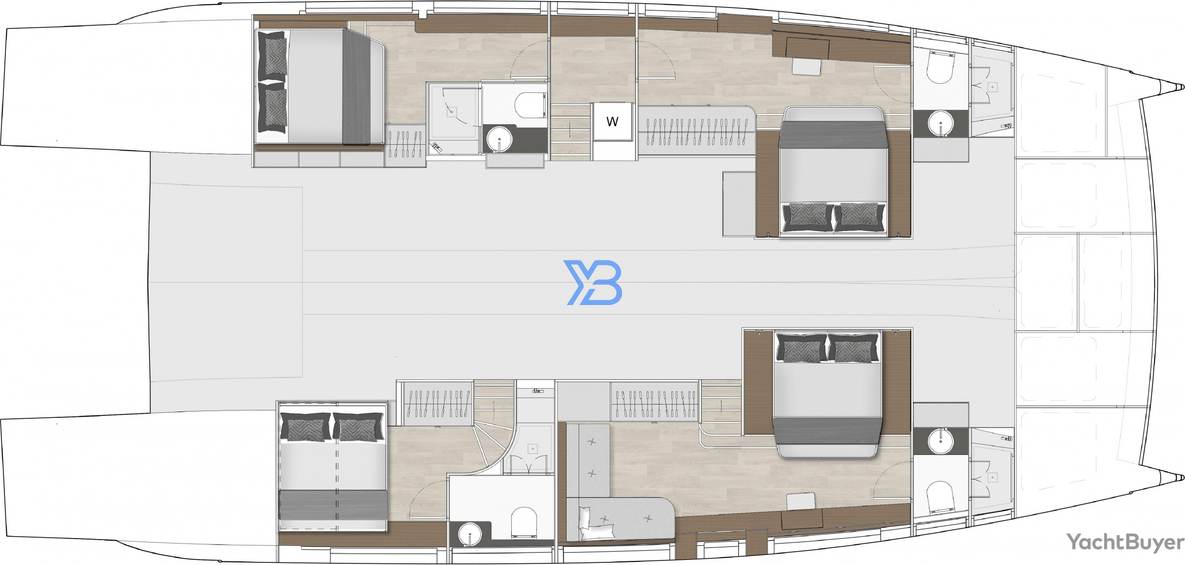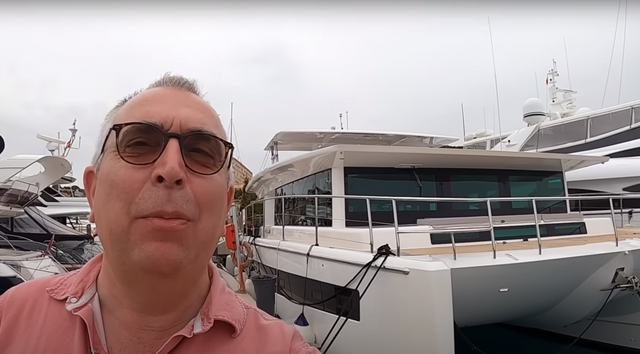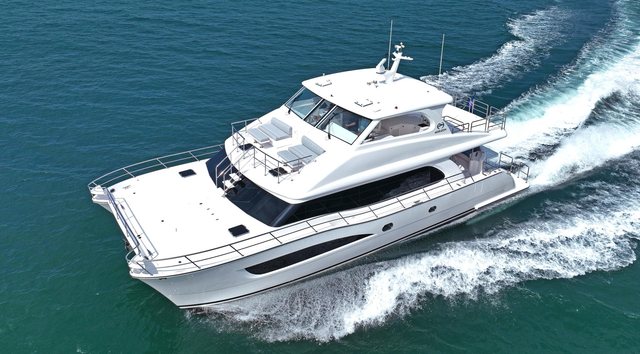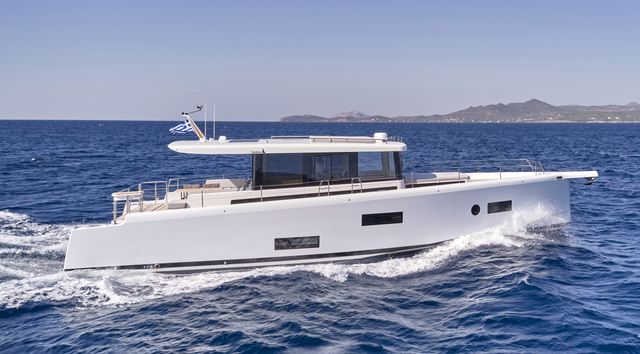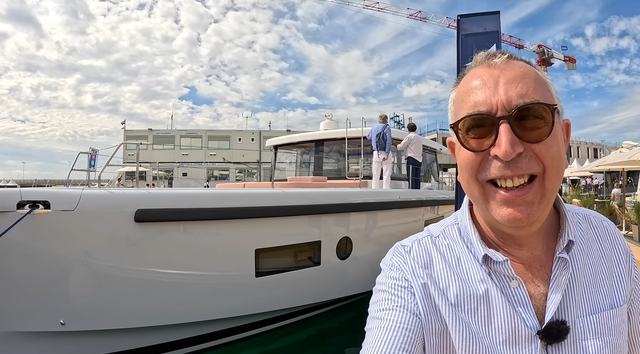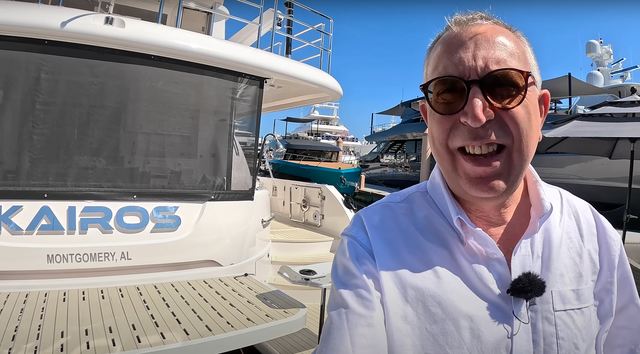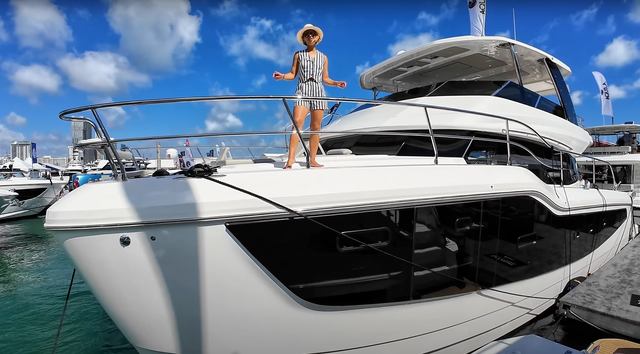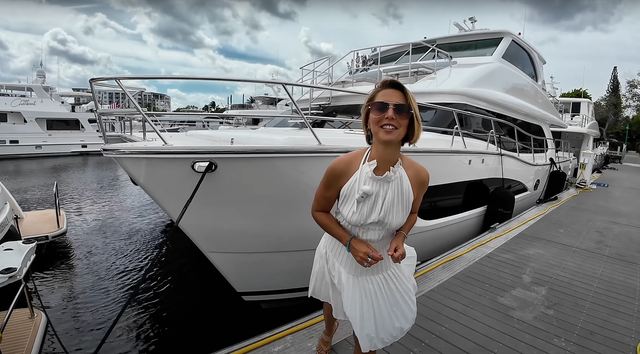With four guest cabins, a forward owner’s stateroom, and dedicated crew space, this walkthrough covers the complete layout, onboard systems, and liveaboard functionality. From the expansive cockpit and sugar scoops to the flybridge lounge and kite-assisted electric propulsion, discover how this first-in-series catamaran is built for quiet, long-range cruising.
Video Tour
On Deck
The sugar scoop on this yacht is massive. Way bigger than what you usually get on a catamaran. It immediately feels like a different class than the Silent 55. Port side features a big foldable swim ladder that extends out nicely and makes it really easy to get in and out, especially at floating docks. The passerelle setup here is pretty slick too - it pins in securely and can swivel, so you can still use it even when you’re not perfectly aligned with the dock. There are rollers on the end, and a chafe guard built in. Starboard scoop mirrors this - another swim ladder, another transom shower, shore power inlet, hose hookup for washdown. Simple and super usable.
Those big hatches aft are access doors to the engine and electric motor rooms. Above the platform sits the Tenderlift hydraulic system. Drop it down and you’ve got yourself a floating beach club that connects the two scoops. Keep it raised and it still forms a solid terrace for hanging out.
The cockpit itself is vast. There’s a large dining table that easily fits 8, just throw a few more chairs around and you're set for dinner. The seating has sliding backrests mounted on tracks, which feels like an upgrade from the usual reversible types that break if you look at them wrong. Beneath the seats are three oversized lockers. One of them swallows four full-size paddleboards. Another is fitted with a removable Dometic cooler - not built in, which is great, because you can pre-chill it and take it ashore. The third locker matches the first and can be used for fenders, lines, snorkel gear, whatever you’ve got.
Walking forward, the side decks feel taller and wider than expected. The rails are high, the overhang is huge, and everything’s solid. They’ve carved out the headroom around the overhang so even tall folks won’t bang their heads. The roof structure is all about maximizing solar panel space, and you can see how they’ve stretched the design to make it count.
Up front, the foredeck is fully solid (no trampolines) and fitted with two wide princess seats built into the moulding. Underneath, the port side hatch opens to reveal a small crew cabin. It’s fully finished, with a single bunk, proper wardrobe, hatch above, porthole outboard, and a surprising amount of extra storage tucked into every available space. The starboard side holds the wet head - shower, sink, toilet, more storage.
Also forward is a windlass setup with anchor chain locker, chain wash, stainless steel gear, and foot controls. There’s even a secondary anchor locker. Everything’s on gas shocks and cleanly mounted.
Right in the centre is the big surprise - the kite sail system. This thing is serious. Commercial-grade setup stored in a dedicated locker, complete with four tie-down points and mounting space for the pole. The kite is like a scaled-up kiteboard sail, designed to launch itself and fly figure-eight patterns to give you propulsion without using battery power. Reports say it can add 4 knots of speed. It’s mainly useful for long crossings, but it’s there, and it’s impressive. No sailing experience required - just some tech sense and caution with your lines. For a yacht built around electric cruising, it’s a smart backup that gives you wind assist without needing masts or sails.
Access to the flybridge comes via both side decks - they’re wide and safe all the way up. The flybridge itself keeps things simple by design. It’s not oversized because most of the roof space is reserved for solar panels. But there’s still room for sunpads with adjustable backrests, a convertible high-low table, and seating with reversible backs. Overhead is a big hydraulic roof that can lower completely flush with the superstructure. When it’s raised, you’ve got built-in speakers and lights. When it’s down, no shade hits your solar panels and the silhouette stays clean.
Interior Accommodation
Step through the massive sliding door and you're straight into the galley. It’s full beam, split between the starboard and port sides, and it feels like a proper home kitchen. On starboard there’s a tall locker for bulky items like a vacuum, plus a fire extinguisher tucked in. Next to that sits a side-by-side fridge and freezer that looks like something you'd install in a real apartment.
Across to port, you’ve got loads of drawers, deep storage, and a long counter. A metal rail runs the full length under the cabinets. It’s subtle but properly clever. You could hang tools, mugs, even oils or utensils if you’re cooking under way. The galley has an induction cooktop with flexible zones, a full oven, and a built-in dishwasher. The coffee machine is a sleek unit built into its own housing, and there are drawers everywhere you look. It’s got the kind of setup you’d actually want to use daily.
There’s natural light pouring in from all sides. Big windows surround the saloon and you can open sections on both sides to get a cross breeze going. The headroom is wild. It feels more like a loft than a boat interior - over three metres high. This is the raised version of the Silent 60 layout. Newer hulls will follow this format and even expand the space beneath.
Just forward of the galley is the interior dining area with a huge table and proper seating for up to ten people. There's a TV lift neatly tucked into the cabinetry, and extra drawers underneath the windows. It’s big, but not flashy - it feels like something you could actually live with long term.
The lower helm is forward to starboard. It's set up with a double bench, fold-up bolsters, and a view over the entire bow. There’s a full Simrad setup including chartplotters, cameras showing the anchor and stern, and full monitoring for battery levels and power use. No wheel here - instead there's a rudder joystick that doubles as an autopilot controller. A Dockmate remote system is included too, so you can walk to the aft deck or side deck with full control while docking. Everything is reachable - the C-Zone screen, bow thruster toggles, chain counter, anchor video feed, VHF, and even a good old-fashioned compass.
Beneath the saloon floor is where the power lives. The 10 kW house bank supports all 220V systems and gets first priority from the solar panels. Once that’s topped off, the system starts charging the engine battery banks - three separate banks of 14 batteries each, totalling 210 kW. A small floor hatch near the helm opens to show part of the setup. You can see how neatly the battery layout is installed right down the centreline.
Owner's Cabin
The owner cabin sits forward and spans the full beam in the raised section of the main deck. It's big, bright, and feels like a proper stateroom. The bed is a king size with full walkaround access and two huge nightstands that almost look oversized. You get opening hatches on both sides - these double as escape routes but also work well for ventilation. At night, opening them up gives you a good cross breeze without needing to run the AC.
There’s a built-in desk to starboard - a decent size with room for a laptop and a few personal items. Alongside that, there are deep wardrobes with serious storage volume. Behind one of the cabinet doors you’ll find a safe. The hanging lockers are tall and wide, and everything's finished to the same standard as the saloon.
The ensuite layout is split. To port is the main sink and shower room. The sink is unusually large for a yacht this size, with storage underneath and a mirrored medicine cabinet above. The shower is properly sized - same as the VIP cabin - with full standing height and a separate enclosure. Everything feels solid and easy to clean. To starboard, separated by its own door, is the toilet compartment. It’s a fully private head with a porthole for ventilation and extra built-in storage for toiletries.
Guest Accommodation
The guest layout on this Silent 60 is a bit of a choose-your-own-adventure setup. All the cabins are slightly different, which makes it easier to assign based on who gets along with who. On the port side there are two cabins - one forward and one aft. Then there's a single VIP on the starboard side that runs almost the full length of the hull.
Starting aft on port, you get a king-size bed tucked in sideways with a little bit of ledge space if you need a break from your bed partner. There’s a full-height hanging locker and some clever open shelving for quick-access storage. This cabin has big windows and a lot of light, which helps open up the footprint. The ensuite is cleverly done with glass partitions that let daylight in from the cabin. It’s not massive but feels open - full shower enclosure, electric toilet, storage beneath the sink, and space for toiletries. The pocket door saves space without getting in the way.
Forward on the same side is another guest cabin that almost feels like a VIP. You’ve got big hull-side windows and three portholes that open, which is rare. There's tons of storage built into the cabinetry and another set of overhead lockers along the outboard wall. The bed isn’t walkaround, but that tradeoff gives you more usable space around the room - a small desk, drawers under the bed, and a proper standing area. The ensuite is basically identical to the aft cabin, again with a glass wall, full shower and sink.
Then there’s the starboard VIP, which stretches out almost the full length of the hull. This is the one that feels closest to a secondary owner cabin. The bed runs fore and aft and there’s a ridiculous amount of storage - lockers, drawers, open shelves, even a drawer under the bed. You also get large windows and a porthole that opens. The ensuite is split off behind a door, fully private from the sleeping area. There’s enough room here to get dressed, hang out, and actually feel like you’re in your own space. The shower is huge - genuinely a two or maybe even three person size, with a sea view if you happen to be anchored somewhere nice. The toilet and sink area has its own medicine cabinet, open shelves and more lockers.
Crew Accommodation
Crew accommodation on the Silent 60 is in the forward sections of both hulls. It’s easy to miss at first glance, but both sides are fully finished and designed to be practical without taking up too much space. These aren’t big cabins, but they’re not token bunks either.
Starting on the port side, the forward locker lifts to reveal a proper little cabin. It’s finished to the same standard as the rest of the boat - same wall panels, same cabinetry style. There’s a single bunk, a decent-sized hanging locker, and storage running all the way forward. You get an overhead hatch and a fixed porthole for ventilation. It’s tight, but usable. If you're not running with crew full time, it's a great space for overflow guests, a teenager, or even a specialist like a dive guide or chef brought on for a trip. It could also just be excellent bonus storage if you're living aboard and carrying a lot of gear.
Over on the starboard side is the companion compartment - the wet head. It’s got a sink, separate shower with its own handheld unit, an electric toilet, and two big storage lockers. There’s also another porthole here, so it’s not a dark little box. The floor drain sits dead centre and the entire unit is finished cleanly so it’s easy to rinse and dry out.
For a 60-foot yacht, this setup makes a lot of sense. You’re not stuffing a full crew into tight quarters like you would on a charter yacht. Most owners will run this boat themselves or bring someone in only when needed. These crew cabins give you the flexibility to scale up when necessary - or just stash more stuff when you're not. It’s also worth noting how discreet they are. Nothing about the foredeck gives away the fact that there’s accommodation tucked underneath until the hatches open.
Performance
Access to the engine rooms is one of the most impressive parts of the Silent 60. Instead of the usual small deck hatches you get on most cats, this yacht has full-size swing-up access doors in the aft deck. You don’t have to squeeze in from above or crouch under a hatch while getting dripped on. These open wide and you walk straight in, shaded and out of the weather.
Inside the port compartment is where it gets interesting. The electric motor is small - surprisingly so. You look at it and go, that’s it? But it’s all clean and logical. Straight shaft runs aft through a dripless seal. The space is well lit, easy to move around in, and everything is clearly laid out. On this side you’ve got the generator - a Volvo Penta D3 220. That’s not a propulsion engine, it’s the backup power unit. It kicks in when you’re doing longer trips and need to charge up the main battery bank. There's a control panel mounted right on the bulkhead, fire suppression system installed, and a full monitoring unit for generator runtime and load.
There are two watermakers down here as well - 24V units with a combined capacity of around 75 litres per hour. That's a solid output for a solar-powered yacht, especially when running off battery. All of the systems are cleanly installed with proper insulation around the compartments to cut down noise from the watermakers or the generator when they’re running.
The starboard side mirrors the port but without the generator. That means even better access to everything else - filters, shaft, pumps, and breakers. If you need to do maintenance, you’re not crawling over hot machinery. It’s all laid out for real-world use.
Performance is exactly what you'd expect from a solar electric catamaran - efficient and quiet, not fast. The yacht cruises at around 5 knots for up to 18 hours using just the 180 kW battery draw (keeping 20% reserve). Push up to 8 knots and your range drops to 3-4 hours, but that speed is there if you want it. For short repositioning runs or hopping to the next anchorage, 8 knots works fine.
Where it gets really clever is when you combine that with the kite system. Drop your cruising speed to 4 knots on battery and the kite adds on another 4. Suddenly you're doing 8 knots using only the energy it takes to power the motors at half that speed. That kind of hybrid thinking changes how you plan longer legs. You can extend your range without touching the generator.
This kind of tech-forward layout reflects how much has shifted since the earlier Silent 55. Solar panels are more efficient. Battery storage has improved. And now, with systems like the kite assist, you’ve got a completely new way to cross longer distances while keeping power use low.
Ownership Considerations
The Silent 60 is clearly built around the idea of energy independence. This isn’t just a catamaran with solar panels on the roof - the entire platform is designed to run primarily on solar and battery power, backed up by a single diesel generator for long-range security. That makes it especially appealing for owners who want to cruise quietly, avoid the noise and heat of engines, and stay off-grid for longer stretches.
The house battery bank is 10kW, which handles all the 220V appliances and systems onboard. Once that’s full, the solar input shifts to the 210kW propulsion battery bank, split into three separate banks with 14 batteries each. That scale of capacity allows for 18 hours of low-speed cruising at around five knots without using the generator at all. If you bump up to eight knots, you’re down to around 3-4 hours - but for short hops between anchorages, that’s still plenty.
When conditions aren’t sunny or you’re crossing longer distances, the Volvo D3 220 generator steps in. It’s not designed for constant use, but it can recharge the battery bank in a few hours and let you switch back to silent running. You’re not stuck idling a diesel all day. Most of the time, you’re running silently, with the generator only filling in when needed.
Maintenance is simplified by the open access to machinery. Both engine compartments are easy to get into, and there’s no complicated propulsion system. The electric motors are compact, reliable, and low maintenance. All service points are reachable without contorting yourself through a hatch or removing panels. It’s clearly been thought through for owner-operators.
Crew needs are optional. You can run this boat as a couple - most systems are manageable solo, especially with the Dockmate remote for mooring. But if you want to bring a captain or extra hand occasionally, there are proper crew cabins ready. They don’t take up much space, and they’re out of the way when you don’t need them.
As with any wide-beam catamaran, it’s worth keeping in mind that berthing can be more expensive in some marinas. The extra width means you may need to book a double berth or reserve more space than a monohull of similar length.
In terms of rivals, the Silent 60 Flybridge competes with other solar-capable or power cat designs like the 60 Sunreef Power Eco and the Aquila 50 Yacht - both offering similar liveaboard volume and long-range ambition, but with different approaches to propulsion and energy systems.
In Summary
The Silent 60 isn’t trying to be loud about its innovation, but it’s doing something bold all the same. This is a yacht that rethinks how you cruise and how you live aboard - quietly, cleanly, with almost no compromise. It’s big where it needs to be, clever in the right places, and built with a kind of quiet confidence that shows up in the way drawers glide, backrests slide, and hatches swing open like proper doors. For owners who want to explore without a diesel drone in the background, and without giving up real-world comfort, the Silent 60 makes a likeable case for doing things differently.
Looking to own a Silent 62 Flybridge? Use YachtBuyer’s Market Watch to compare all new and used Silent 62 Flybridge Powercats for sale worldwide. You can also order a new Silent 62 Flybridge, customized to your exact specifications, with options for engine choice and layout configuration. Alternatively, explore our global listings of new and used powercats for sale and find your perfect powercat today!
Specifications
- Builder Silent Yachts
- Range 60 Series
- Model Silent 62 Flybridge
- Length Overall 61' 11"
- Beam 29' 6"
- Draft 4' 2"
- Hull Composite
- Cabins 4
- Berths 4
- Cruising Speed
- Max Speed
- Fuel Capacity 423 Gallons
- Fresh Water Capacity 264 Gallons
Interested in a Silent 62 Flybridge?
NEW Build
Find your local dealer for a personalised, no-cost consultation
or just request
Brochures & Pricing
Used & In Stock
Looking for a ready-to-go Silent 62 Flybridge or pre-owned options? Explore all inventory of the Silent 62 Flybridge available worldwide
